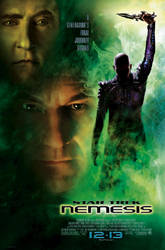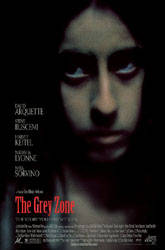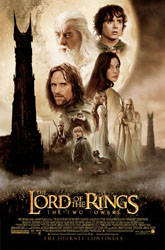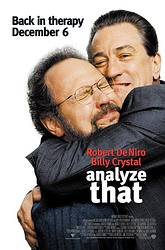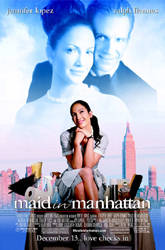 Director: Starring:
OTHER REVIEWS: |
Maid in Manhattan BY: DAVID L. BLAYLOCK "Don't be fooled by the rocks that I've got, I'm still, I'm still Jenny from the block." Jennifer Lopez's latest single, "Jenny from the Block" looks at the way fame and fortune has not changed her, she's still that Puerto Rican girl from Bronx. Regardless of the hit records and the hit movies, the upcoming perfume line, the much-gossiped marriages, the engagement to Ben Affleck -- she's still, she's still Jenny from the block. Her latest film Maid in Manhattan tries to work with the same idea, that Jennifer Lopez, in working class garb or upper class attire, is still that same down-to-earth girl. And it is testament to the truth within this statement that Maid in Manhattan succeeds in convincing the audience that Jennifer Lopez is, in fact, as real in her millionaire life as she would be in any other life had she not succeeded. In the film she plays Marisa Ventura, a maid at the Beresford Hotel, a classy joint that caters to the upper echelon of New York. One of the employers (Conroy) names off the VIP guests: a pair of French kleptomaniacs, Caroline Sinclaire (Richardson), a posh society woman just dumped by her shallow boyfriend, and Christopher Marshall (Fiennes), a Republican state assemblyman preparing to run for his late father's U.S. Senate seat. Marisa is assigned to the floor that includes Caroline and Christopher. Pushed by her best friend Stephanie (Matrone), Marisa tries on one of Caroline's Dolce & Gabanna suits. When her son Ty (Posey) happens to woo Christopher with his knowledge of Richard Nixon, and the wealthy politico sees Marisa in the $5,000 attire, he assumes that he is with his own. After a little stroll together through Central Park, it seems that this Cinderella has found her prince. All she has to do is make sure that Christopher doesn't figure out that she is the 22nd floor's maid instead of its resident. Meanwhile, Christopher gets himself caught up in an unfortunate relationship with the real Caroline after inviting her to lunch thinking he was inviting that "slightly Mediterranean" woman who lives on the floor. He hates Caroline and wishes nothing more than to find Marisa again; meanwhile, Marisa attempts to remain invisible (as the signs downstairs tell all the chambermaids to be) and Caroline tries to push herself into Christopher's life. There's a big ball and a fairy godmother and even a collections of birds and mice to complete this Cinderella tale, helping to give the film a enchanting air that it deserves (unlike other, more overtly magical romantic comedies that fail like Simply Irresistible and Practical Magic). This is not a film that strives for reality, but it is nice, pat, and innocuous in its dallying with a inter-economic, interracial relationship. While Lopez creates the working class with the resolve that Mariah Carey couldn't seem to find in Glitter, Fiennes does little more than playing upper-class convincingly. Everything else -- the mannered friend of the kids, the unquestioning lover, the mobile politician -- seems to be forced out of Fiennes as if he doesn't want to play anything this light after Charles van Doren and Evgeny Onegin. He is a great actor, despite what come critics have called him (I remember one detractor said he was proof that critics will embrace anyone with an accent) but he is just not romantic comedy material. I'm not 100% sure that this is because he cannot do it, but merely that his heart isn't in it. He may not think that this genre is deserving of his time, but someone who proved the power of the genre, like Spencer Tracy or Billy Crystal, might disagree. Once again, Wayne Wang attempts to work with race identities in film, even when he is stifled by the commercial obligations that a film like Maid in Manhattan requires. The director who brought to life Chan is Missing, Smoke, and The Joy Luck Club, has a good feeling for the racial identity that marks the various peoples that walk this nation, especially as they convene to create the multiethnic New York City. In this case, he raises interesting comparisons to the all-white guests and management at the hotel as compared to the all-black and Latino maids and butlers downstairs. The only exception is the well-mannered English butler Lionel Block (Hoskins), who, unlike Stevens in The Remains of the Day, doesn't see the past mores of servitude (all white, English butlers and maids in the best households) as the better time, but embraces the future of blacks and Latinos not only taking the service positions but also moving into management as well. Nearly the entire cast comes from some minority, leaving
lilywhite Fiennes as the outsider. Wang introduces him with all the baggage that a
Republican affliation would have (however unwarranted) and shows that the most maligned
politicians are sometimes just as real and worthy of acceptance as the minorities. Maid
in Manhattan may not be his most incisive look at such issues, but it does show
something of note: even when working on a forgettable little film like this, Wang is not
willing to let his forte be sidelined. |

